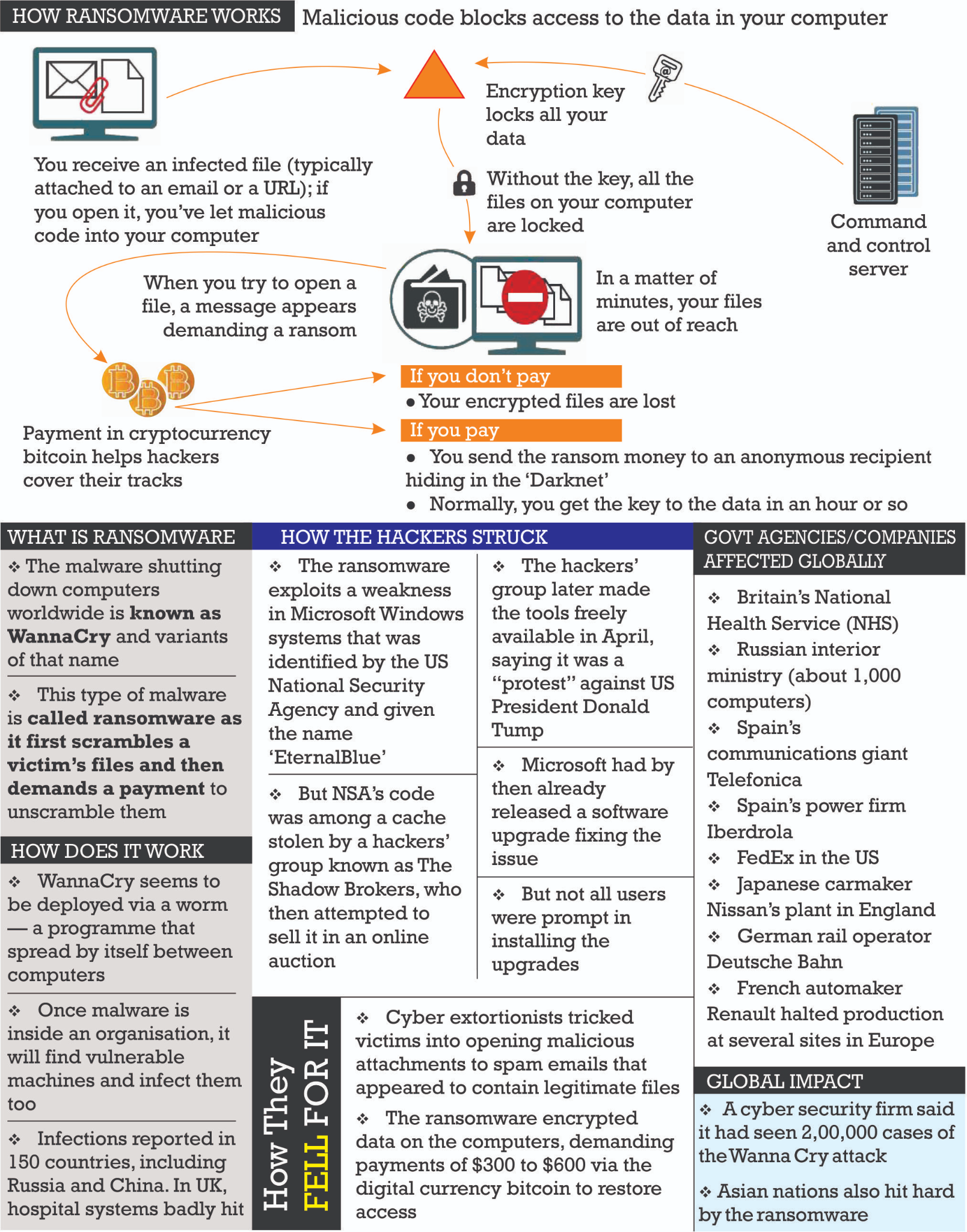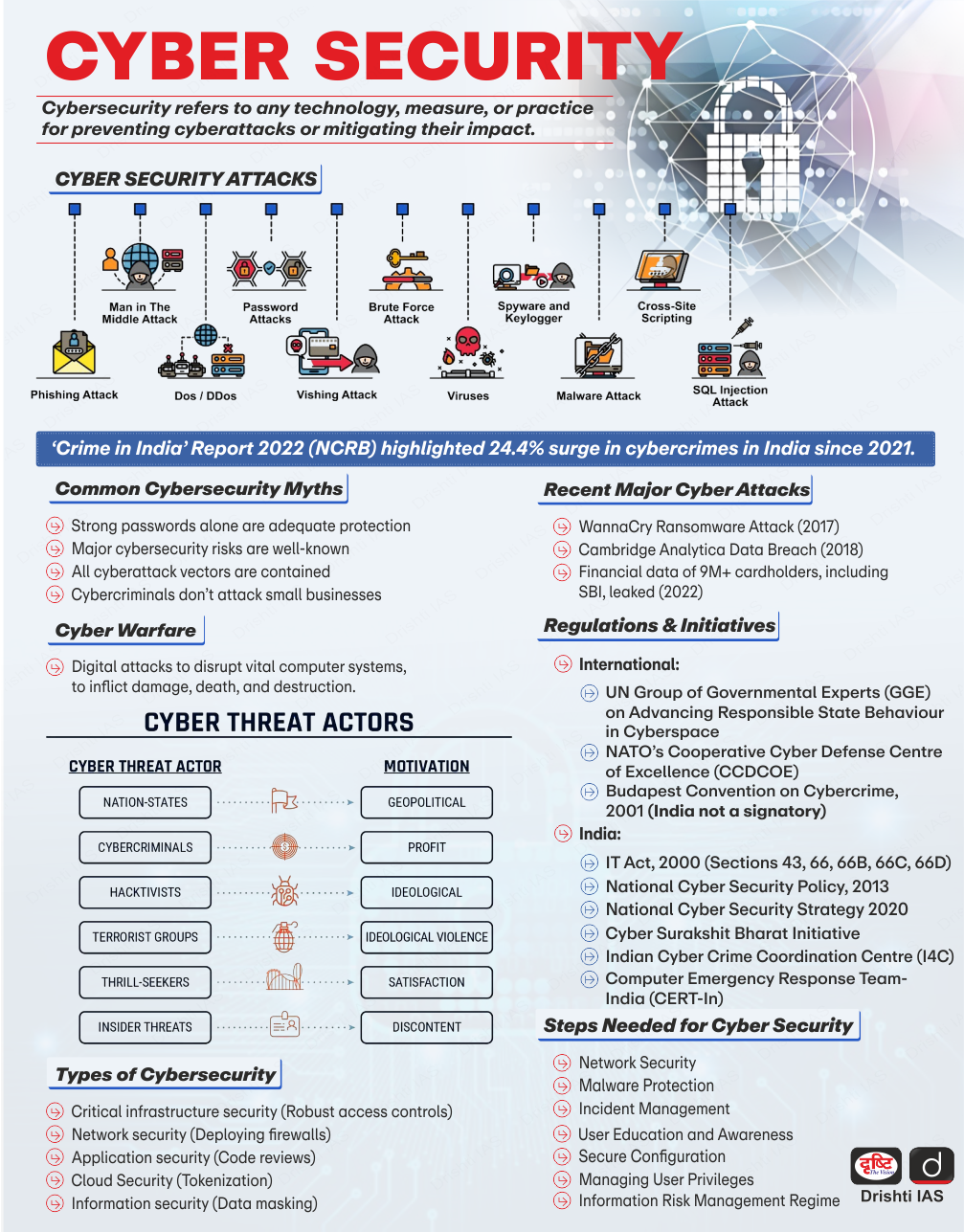Science & Technology
Ransomware Attack Disrupts Bank Operations
- 03 Aug 2024
- 11 min read
For Prelims: Ransomware, Regional Rural Banks, National Payments Corporation of India, Unified Payments Interface, Aadhaar-enabled payment systems, Malware
For Mains: Impact of Ransomware on the Financial Sector, Cybersecurity Measures, Government Initiatives
Why in News?
Recently, a ransomware attack severely disrupted the operations of at least 150-200 cooperative banks and Regional Rural Banks (RRBs) in India.
- The National Payments Corporation of India (NPCI) has identified the attack, which has primarily affected banks serviced by C-Edge Technologies Ltd., a joint venture between Tata Consultancy Services Ltd. (TCS) and State Bank of India (SBI).
How has the Ransomware Attack Affected the Banks?
- The ransomware attack targeted C-Edge Technologies Ltd., impacting their ability to provide services to cooperative banks and RRBs.
- Customers of the affected banks were unable to access payment systems, including Unified Payments Interface (UPI) and Aadhaar-enabled payment systems (AePS).
- Some RRBs, depending on their sponsor banks, continued to function normally as they use different technology service providers.
- Broader Implications for the Payment Ecosystem:
- The attack highlights the vulnerability of technology service providers and their critical role in maintaining the payment infrastructure.
- The incident underscores the need for robust cybersecurity measures to protect against such attacks in the future.
- Cooperation between NPCI, banks, and technology providers is crucial to swiftly address and mitigate the impacts of such disruptions.
Note: AePS is a bank-led model that allows online interoperable financial transactions at Point of Sale (PoS) or micro-ATMs through the Business Correspondent of any bank using Aadhaar authentication.
- It was taken up by NPCI, a joint initiative of Reserve Bank of India (RBI) and Indian Banks’ Association (IBA) to provide easy and secure access to banking services for the poor and marginalised, especially in rural and remote areas.
What is Ransomware?
- Definition: Ransomware is a type of malware that encrypts a victim’s data or locks their device, demanding a ransom for the decryption key or to regain access.
- Early Attacks: Initially, ransomware attacks focused on encrypting data and demanding a ransom for the decryption key.
- Modern Tactics: Recent ransomware attacks have evolved to include double-extortion and triple-extortion tactics:
- Double-extortion: Attackers threaten to leak stolen data online if the ransom is not paid.
- Triple-extortion: Attackers use stolen data to target the victim's customers or business partners.
- Types of Ransomware:
- Encrypting Ransomware (Crypto Ransomware): Encrypts the victim's data, demanding a ransom for the decryption key.
- Non-encrypting Ransomware (Screen-locking Ransomware): Locks the victim's entire device, displaying a ransom demand on the screen.
- Subcategories of Ransomware Include:
- Leakware or Doxware: Steals and threatens to publish sensitive data.
- Mobile Ransomware: Affects mobile devices, often using screen-lockers.
- Wipers: Threaten to destroy data, sometimes even if the ransom is paid.
- Scareware: Uses fear tactics to coerce payment, sometimes posing as legitimate alerts.
- Ransomware as Cyber Threat:
- Financial Impact: Ransomware attacks can cost organisations millions of dollars.
- An IBM (International Business Machines Corporation) report showed that the average cost of a data breach touched an all-time high of Rs 19.5 crore (USD 2.35 million) in financial year 2024, up by around 7% over 2023, with the local industrial sector being the most impacted.
- Ransomware victims and negotiators are reluctant to disclose ransom payments.
- Speed of Attacks: Once hackers gain access to a network, they can deploy ransomware in less than four days, giving organisations little time to detect and respond.
- Financial Impact: Ransomware attacks can cost organisations millions of dollars.
- Steps for Responding to a Ransomware:
- Isolate the infected device from the network to contain the infection. Disconnect all suspiciously behaving devices from the network to stop the spread of infection.
- Identify the entry point by checking for any alerts from any active monitoring platform and identify the ransomware by scanning encrypted files and ransom notes.
- Prioritize the restoration of systems by restoring the most critical ones first, followed by eradication of the threat from the network.
- If backup is available, restore the systems from a backup. Otherwise, try for decryption options.
How does Ransomware Infect Systems?
- Phishing: It is a type of cyberattack that uses Social Engineering tricks to deceive victims into downloading ransomware through malicious attachments or links.
- Social engineering is the use of psychological manipulation to trick users into making security mistakes or revealing sensitive information.
- Exploiting Vulnerabilities: Uses existing or zero-day vulnerabilities to inject ransomware.
- Credential Theft: Steals authorised user credentials to deploy ransomware.
- Other Malware: Use other malware (e.g., Trojans) to spread ransomware.
- Drive-by Downloads: Infects devices through compromised websites.
- Ransomware as a Service (RaaS): Allows cybercriminals to use ransomware developed by others in exchange for a share of the ransom.
Notable Ransomware Variants
- Akira Ransomware
- LockBit Ransomware
- CryptoLocker: Credited with kick-starting the modern age of ransomware in 2013.
- WannaCry: A cryptoworm that attacked over 200,000 computers in 150 countries in 2017.
- Petya and NotPetya: Encrypts the file system table, rendering computers unable to boot.
- Ryuk: Popularized big-game ransomware attacks against high-value targets.
- DarkSide: Responsible for the Colonial Pipeline attack in 2021.
- Locky: Uses macros in email attachments to infect devices.
- REvil: Known for big-game hunting and double-extortion attacks.
- Conti: Operated a RaaS scheme, using double-extortion tactics.
What are the Legislations to Protect Against Ransomware Attacks in India?
- Ransomware attacks constitute various offences under the Indian Penal Code 1860 and the Information Technology(IT) Act 2000.
- The IT Act has relevant provisions include: Section 43 and 66 (damage to computer/system), Section 65 (tampering with computer source documents), and Section 66D (cheating by personation). Additionally, corporate bodies holding sensitive personal data have an obligation to implement reasonable security practices under the IT Rules.
- The punishment for ransomware attacks under the IT Act ranges from imprisonment for a term of three years to seven years and a fine of up to Rs. 1 crore.
- The Ransomware Task Force (RTF) is a specialised unit within India's National Cyber Security Coordinator (NCSC) organisation that serves as a central point of contact for victims of ransomware attacks, providing assistance with investigation, recovery, and prevention efforts.
- Cybersecurity Framework for the Indian Banking Sector, 2018, issued by the RBI provides specific guidelines for banks and financial institutions to protect against cyber threats, including ransomware attacks.
- It mandates banks to implement robust cybersecurity measures, such as multi-factor authentication, encryption, and regular security audits.
Way Forward
- Cybersecurity Enhancements: Banks and technology service providers must implement robust cybersecurity measures, including endpoint protection, network security, data backup, and employee training.
- Improved threat detection and prevention have led to an 11.5% decline in ransomware infections between 2022 and 2023.
- Establish a centralised platform for sharing threat intelligence among banks and financial institutions.
- Data Backup and Recovery: Implement robust data backup and recovery procedures, including offline backups. Develop comprehensive business continuity plans to ensure minimal disruption in case of a cyberattack.
- Enhanced Security Standards: Conduct rigorous security assessments of third-party vendors and partners. Improve incident response capabilities to minimize the impact of cyberattacks.
- Obtain relevant cybersecurity certifications to demonstrate commitment to security.
|
Drishti Mains Question: |
UPSC Civil Services Examination Previous Year Question (PYQ)
Prelims:
Q. The terms ‘WannaCry, Petya and EternalBlue’ sometimes mentioned in the news recently are related to (2018)
(a) Exoplanets
(b) Cryptocurrency
(c) Cyber attacks
(d) Mini satellites
Ans: (c)
Q. In India, it is legally mandatory for which of the following to report on cyber security incidents? (2017)
- Service providers
- Data centres
- Body corporate
Select the correct answer using the code given below:
(a) 1 only
(b) 1 and 2 only
(c) 3 only
(d) 1, 2 and 3
Ans: (d)
Mains:
Q.What are the different elements of cyber security? Keeping in view the challenges in cyber security, examine the extent to which India has successfully developed a comprehensive National Cyber Security Strategy. (2022)
Q. Discuss the potential threats of Cyber-attack and the security framework to prevent it. (2016)






